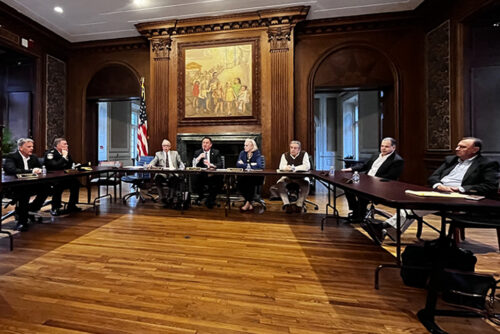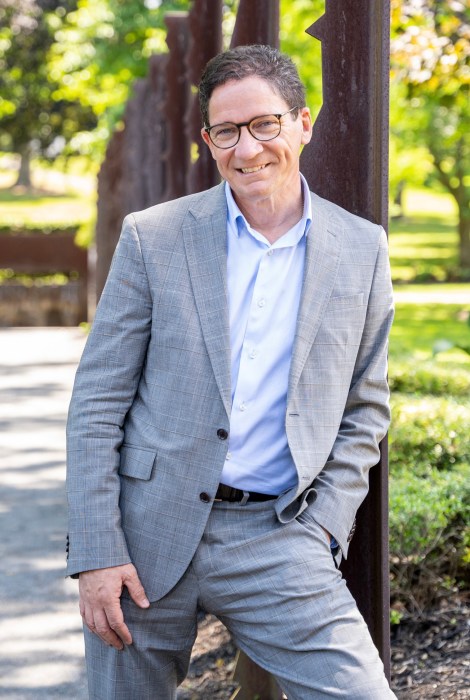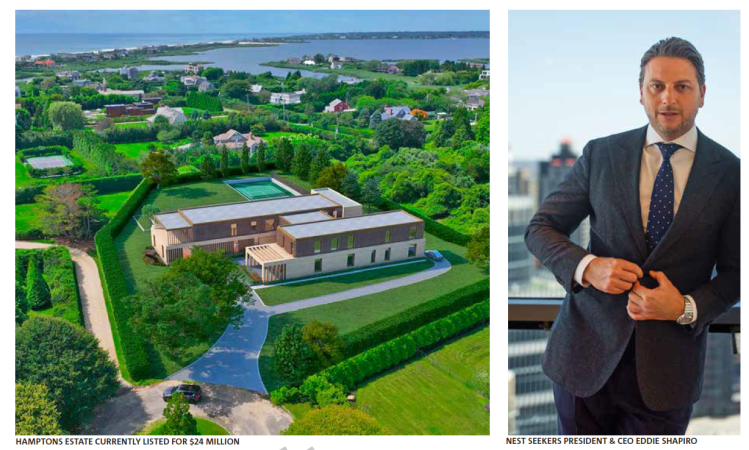Village of Brookville Town Hall discusses Tam O’Shanter property
No more seats were left as residents poured into the Village of Brookville’s Town Hall Meeting at AHRC Nassau on the evening of March 26 to discuss the Tam O’ Shanter golf course property. The meeting allowed residents to voice their questions and concerns about the property.
According to the Village of Brookville’s newsletter, The Voice of the Village, the 148.82-acre Tam O’Shanter golf course was sold to Titan TAM LLC/Sigme TAM LLC for a reported $15 million over five years ago.
Village of Brookville Mayor Daniel H. Serota explained at the beginning of the March 26 meeting that two years prior, the Planning Board granted preliminary subdivision approval to permit the subdivision of the Tam O’Shanter property into 29 lots. Twenty-seven of those lots would be single-family homes with an average lot size of 5 acres. One lot would contain a stormwater recharge basin and another would be transferred to the Village of Brookville for future municipal use. Serota said the subdivision fully complies with the village’s master plan and zoning and subdivision regulations. The subdivision also includes conservation and scenic easements located around the entire property perimeter.
“At that time, the village hired an environmental consultant pursuant to the State Environmental Quality Review Act (SEQRA),” said Village of Brookville Attorney John M. Chase. “The Planning Board was required to take a hard look at the environmental impacts of the project, and as a result of that study, the Planning Board did identify and acknowledge in its negative declaration pursuant to SEQRA, that there was contamination in the soil resulting from fertilizers which result in arsenic and other metals. So at the time that the Planning Board approved the subdivision and issued its negative declaration to SEQRA, it was very clear that the Planning Board required that this contamination had to be remediated.”

As a condition to the subdivision’s approval, the developer was required to obtain approval from the Nassau County Department of Health that the soil had been tested and approved as safe.
After reviewing more than 200 test soil borings throughout the acreage, the Department of Health found elevated arsenic levels resulting from its use as a golf course. To move forward, the Department of Health requires 135,000 cubic yards of soil to be removed, disposed of, and replaced with clean topsoil to restore the property to safe conditions for people to reside.
To do that, over an estimated one-year period, 11,000 dump trucks would make round trips into the village to remove the soil and thousands of other dump trucks would return, bringing in the clean soil. The perimeter of the golf course would remain relatively untouched because most of the contamination is in the fairway, the part of the golf course between a tee and the corresponding green, where the grass is kept short.
The Department of Health will not allow this soil removal to be done in stages, and soil remediation is the department’s only option for the 27 homes to be built.
The Department of Health, Chase explained, is the sole agency that has jurisdiction over the cleanup.
“Obviously, the mayor and the Board of Trustees are now concerned that draconian method of cleaning up the site is not only going to result in 23,000 truckloads, but the noise, the carbon monoxide, the pollution, the destruction of village roads, and on and on, what anybody with common sense could figure,” Chase said. “That’s where it stood until the developer came before the village with an alternative proposal to remediate the contamination.”
Jack Martins, the 7th District State Senator representing the developer as a private council, stood before the village residents to present plan A and B options to remediate the soil. Also, there was a developer, Efrem Gerszberg, in attendance.
Option A, which the Department of Health presented to the developer, requires the removal of topsoil throughout most of Tam O’ Shanter. Martins said that the impacts of this process on the community would be significant, considering the number of trucks that would be involved.
As part of this effort, Martins stated that the applicant and developer have been approved for brownfield tax credits by the New York State Department of Environmental Conservation, which would offset the cost of removing the soil.
Option B, Martins explained, involves examining best practices in other jurisdictions that have dealt with soil remediation.
“What the developer did was went out, hired consultants and looked at exactly the alternative: milling in place or tilling in place,” Martins said. “There’s equipment that does that. It allows for the areas to be broken up into grids, to do grids independently, to have the village have its own consultants review and oversee it, to do each piece independently and evaluate before moving on to the next piece, to ensure that we are actually addressing the issue, but also doing it in a way that is in keeping with the village’s expectations and certainly with a minimum impact to the surrounding properties.”
This process would also allow trees on the property to be preserved, because the equipment could till around them.
“We have spoken to Nassau County,” Martins said. “They have agreed that it is the village’s decision to permit this to go forward. They have no objection. What they do want is to make sure that the land and the property is compliant with state and environmental regulations and as long as we’re below the thresholds and we’re compliant, they do not have an issue with us moving forward with the second plan.”
Chase stated that the village plans to hire its own environmental consultant to ensure that the remediation is done in a manner that protects the residents’ health.
“I can assure you that the means, methods and techniques of this implementation of such a plan will be reviewed and approved and monitored and supervised throughout the process by the village and its engineers,” Serota said. “The health and safety of the residents is my charge as mayor and also the charge of the trustees and the village will require a written sign-off from the health department that the property has been remediated and cleaned up to satisfaction and conditionally safe for people to reside.”
However, many residents attending that evening expressed discomfort about moving forward with either option.
For starters, residents were concerned if Martins’ role as private council is a conflict of interest because he’s a state senator and his jurisdiction includes the Village of Brookville.
“Being a state legislator is a part-time job,” Martins said. “People do their work during the year and then they go up to Albany in order to represent the community. I do happen to be a lawyer. That’s how I support my own family. So my choice to run for State Senate has nothing to do with the fact that I continue to be a practicing lawyer as well.”
Not addressed at the meeting, but should be noted, is as reported by the Five Towns Herald, that Gerszberg, the co-owner of Woodmere Club, is currently in a lawsuit with the villages of Lawrence and Woodsburgh for $65 million in damages, money they have claimed to lose due to limitations the Coastal Conservation District imposed on their plans to develop the land. According to the article, Gerszberg and co-owner Robert Weiss purchased the club property in 2017, proposing the building of 284 single-family homes on it. However the plan was met with opposition by residents and elected officials, and the Coastal Conservation District was created by the Town of Hempstead and the villages to subdivide the property into three districts and reduce the scale of the plan.
Serota told the Syosset Jericho Tribune that the village is not concerned about this pending litigation but is concerned about residents’ fear of any resulting air pollution from the Tam O’Shanter project through either option of soil remediation.
“As a father, I’m very concerned about what this may mean for our family,” said Brookville resident Jason Richter, who works in commercial real estate.
Richter then asked at the meeting if the property was left as a golf course, would it be harmful if the soil were to stay and remain. He also asked what route the trucks carrying the soil would take.
The trucks would enter the property opposite Tappentown Lane and exit off of Route 107.
If the property remained a golf course, it wouldn’t be hazardous as the arsenic is bound in the soil. However, the property remaining a golf course is not currently on the table.
Resident Philip Ragno asked a three-part question pertaining to what will be done with the grass, whether the introduction of sewage systems and roads will reintroduce arsenic to the environment, and whether the new homeowners on this property will be informed that their home was built on what was an environmental concern.
The developer confirmed that the grass will be tilled with the rest of the soil, becoming organic material. Once the remediation is complete and the ratios of the heavy metals are within limits, safety will no longer be an issue.
“I understand the developer’s right to build; that’s very obvious,” resident Fran Gutleber said. “But I don’t understand the right in putting our health at risk… We all breathe in this air and I think it’s a big concern to our safety in this community.”
The developer confirmed that air quality will be monitored throughout the process. The machinery itself shrouds the operation to keep dust from being kicked up into the air. Dust control measures will also take place.
Towards the end of the meeting, residents expressed other ideas for the property, such as building townhouses or residential properties on parts of the property that are not contaminated. Others said they would like the property to be left alone or to become a park or a country club.
“They’re very concerned about the soil and the airborne particles and we have to give that serious thought,” Serota told the Tribune the day after the meeting. “We have to deliberate on it. It’s not the Board of Trustees or the mayor that decides this; it’s the Planning Board. But we are the guardians of the village and we have a stewardship that we take care of the village, so it’s something we’re all going to have to debate and talk about. There’s no decisions being made right now.”































